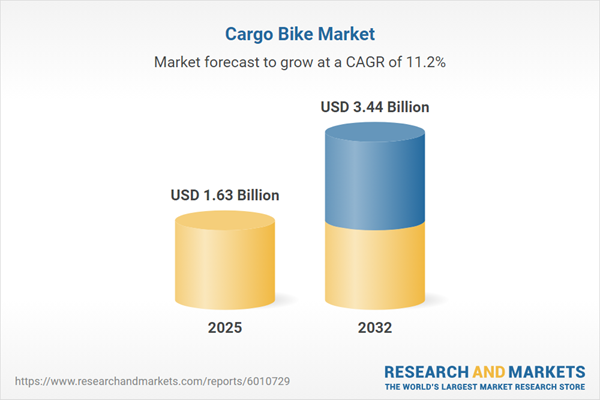Speak directly to the analyst to clarify any post sales queries you may have.
The cargo bike market is undergoing rapid transformation as urban environments prioritize sustainable logistics and efficient last-mile solutions. This report is tailored for senior decision-makers seeking critical insights, actionable strategies, and a clear understanding of regional dynamics, competitive innovation, and strategic opportunities within the evolving cargo bike sector.
Market Snapshot: Cargo Bike Market Size and Growth Trajectory
The Cargo Bike Market grew from USD 1.46 billion in 2024 to USD 1.63 billion in 2025. It is expected to continue growing at a CAGR of 11.23%, reaching USD 3.44 billion by 2032. Businesses and municipalities are driving adoption as they address growing demands for eco-friendly, rapid last-mile delivery, propelled by regulatory pressures and changing urban infrastructure investments.
Cargo Bike Market Scope & Segmentation
- Propulsion: Electric, Non-Electric
- Application: Commercial Logistics, Postal Services, Retail Supply, Household Use, Family Outings, Grocery, Pet Transport, Last-Mile Delivery, E-Commerce, Food & Beverage, Healthcare
- Load Capacity: 100 To 200Kg, Above 200Kg, Up To 100Kg
- Distribution Channel: Offline Stores, Online, E-Commerce Platforms, Manufacturer Websites
- Region: Americas, Europe, Middle East & Africa, Asia-Pacific
- Countries & Subregions: United States, Canada, Mexico, Brazil, Argentina, Chile, Colombia, Peru, United Kingdom, Germany, France, Russia, Italy, Spain, Netherlands, Sweden, Poland, Switzerland, United Arab Emirates, Saudi Arabia, Qatar, Turkey, Israel, South Africa, Nigeria, Egypt, Kenya, China, India, Japan, Australia, South Korea, Indonesia, Thailand, Malaysia, Singapore, Taiwan
- Company Coverage: Accell Group N.V., Rad Power Bikes, Inc., Riese & Müller GmbH, Babboe B.V., Urban Arrow B.V., Yuba Bicycles, LLC, Tern Bicycles GmbH & Co. KG, Triobike GmbH, Christiania Bikes A/S, Winther A/S
Key Takeaways: Strategic Insights for Decision-Makers
- Adoption of cargo bikes is rising as cities implement stricter emissions standards and build cycling-specific infrastructure, improving delivery efficiency in congested urban areas.
- Innovation in battery technology and lightweight materials is extending operational range and payload capacity of electric-assisted models, enhancing their viability for diverse commercial uses.
- Collaborations between public agencies and private sector players are driving investments in dedicated cycling corridors and logistics micro-hubs, facilitating large-scale urban deployment.
- Data-driven fleet management tools, including real-time route optimization and predictive maintenance, are enabling greater operational control for logistics companies.
- Distinct regional dynamics present opportunities: Americas focus on sustainability mandates, EMEA benefits from regulatory incentives and historic urban settings, while Asia-Pacific leads in electrification and supply chain innovation.
Tariff Impact on the Cargo Bike Market
Tariff adjustments scheduled for the United States in 2025 are influencing global sourcing, prompting manufacturers to localize assembly and renegotiate supply contracts to mitigate cost increases. Companies are optimizing shipment consolidation and inventory management to absorb new duties, while transparent stakeholder communication is maintaining confidence through industry shifts.
Methodology & Data Sources
This report leverages a comprehensive research design that combines primary interviews with industry executives and mobility experts, along with secondary analysis of government publications, trade association papers, and technical journals. Triangulation and rigorous data verification enhance reliability and credibility across all market insights presented.
Why This Report Matters for Senior Decision-Makers
- Provides reliable strategic intelligence for investment, partnership, and product development decisions in a fast-evolving market.
- Equips leaders with actionable recommendations and a granular view of regional trends, technology adoption, and supplier dynamics for risk mitigation and value capture.
Conclusion
The cargo bike sector is reshaping urban logistics by offering practical solutions aligned with sustainability, regulatory, and operational goals. This report delivers clarity, deep segmentation, and strategic foresight essential for navigating emerging opportunities and competitive challenges.
Additional Product Information:
- Purchase of this report includes 1 year online access with quarterly updates.
- This report can be updated on request. Please contact our Customer Experience team using the Ask a Question widget on our website.
Table of Contents
3. Executive Summary
4. Market Overview
7. Cumulative Impact of Artificial Intelligence 2025
Companies Mentioned
The companies profiled in this Cargo Bike market report include:- Accell Group N.V.
- Rad Power Bikes, Inc.
- Riese & Müller GmbH
- Babboe B.V.
- Urban Arrow B.V.
- Yuba Bicycles, LLC
- Tern Bicycles GmbH & Co. KG
- Triobike GmbH
- Christiania Bikes A/S
- Winther A/S
Table Information
| Report Attribute | Details |
|---|---|
| No. of Pages | 182 |
| Published | November 2025 |
| Forecast Period | 2025 - 2032 |
| Estimated Market Value ( USD | $ 1.63 Billion |
| Forecasted Market Value ( USD | $ 3.44 Billion |
| Compound Annual Growth Rate | 11.2% |
| Regions Covered | Global |
| No. of Companies Mentioned | 11 |









